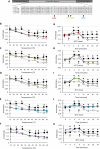Significant influence of four highly conserved amino-acids in lipochaperon-active sHsps on the structure and functions of the Lo18 protein
- PMID: 37923897
- PMCID: PMC10624808
- DOI: 10.1038/s41598-023-46306-6
Significant influence of four highly conserved amino-acids in lipochaperon-active sHsps on the structure and functions of the Lo18 protein
Abstract
To cope with environmental stresses, bacteria have developed different strategies, including the production of small heat shock proteins (sHSP). All sHSPs are described for their role as molecular chaperones. Some of them, like the Lo18 protein synthesized by Oenococcus oeni, also have the particularity of acting as a lipochaperon to maintain membrane fluidity in its optimal state following cellular stresses. Lipochaperon activity is poorly characterized and very little information is available on the domains or amino-acids key to this activity. The aim in this paper is to investigate the importance at the protein structure and function level of four highly conserved residues in sHSP exhibiting lipochaperon activity. Thus, by combining in silico, in vitro and in vivo approaches the importance of three amino-acids present in the core of the protein was shown to maintain both the structure of Lo18 and its functions.
© 2023. The Author(s).
Conflict of interest statement
The authors declare no competing interests.
Figures





Similar articles
-
Production of the small heat shock protein Lo18 from Oenococcus oeni in Lactococcus lactis improves its stress tolerance.Int J Food Microbiol. 2017 Apr 17;247:18-23. doi: 10.1016/j.ijfoodmicro.2016.06.005. Epub 2016 Jun 8. Int J Food Microbiol. 2017. PMID: 27318622
-
A small HSP, Lo18, interacts with the cell membrane and modulates lipid physical state under heat shock conditions in a lactic acid bacterium.Biochim Biophys Acta. 2005 Dec 30;1720(1-2):92-8. doi: 10.1016/j.bbamem.2005.11.017. Epub 2005 Dec 27. Biochim Biophys Acta. 2005. PMID: 16472556
-
Adaptation of the wine bacterium Oenococcus oeni to ethanol stress: role of the small heat shock protein Lo18 in membrane integrity.Appl Environ Microbiol. 2014 May;80(10):2973-80. doi: 10.1128/AEM.04178-13. Epub 2014 Feb 28. Appl Environ Microbiol. 2014. PMID: 24584255 Free PMC article.
-
Is the lipochaperone activity of sHSP a key to the stress response encoded in its primary sequence?Cell Stress Chaperones. 2023 Jan;28(1):21-33. doi: 10.1007/s12192-022-01308-7. Epub 2022 Nov 11. Cell Stress Chaperones. 2023. PMID: 36367671 Free PMC article. Review.
-
Emerging therapeutic roles of small heat shock protein-derived mini-chaperones and their delivery strategies.Biochimie. 2023 May;208:56-65. doi: 10.1016/j.biochi.2022.12.004. Epub 2022 Dec 12. Biochimie. 2023. PMID: 36521577 Review.
Cited by
-
The role of membrane physiology in sHSP Lo18-lipid interaction and lipochaperone activity.Sci Rep. 2024 Jul 24;14(1):17048. doi: 10.1038/s41598-024-67362-6. Sci Rep. 2024. PMID: 39048624 Free PMC article.
-
Stability and dynamics of extradenticle modulates its function.Curr Res Struct Biol. 2024 May 9;7:100150. doi: 10.1016/j.crstbi.2024.100150. eCollection 2024. Curr Res Struct Biol. 2024. PMID: 38784963 Free PMC article.
References
Publication types
MeSH terms
Substances
LinkOut - more resources
Full Text Sources

